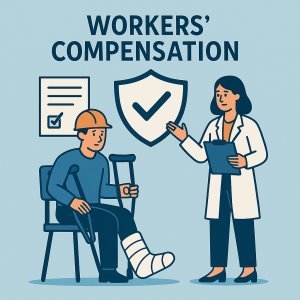
Assigned-Risk Workers’ Comp for GA Personnel Agencies
August 1, 2025
Workers Comp for Delivery Startups: Containing Driver Risk
August 1, 2025
In today’s dynamic workforce habitat, managing employee benefits and compliance can present important challenges for businesses of all sizes. Professional Employer Organizations (PEOs) have emerged as valuable partners, offering comprehensive human resource solutions that streamline administrative burdens. Among these services, workers’ compensation management stands out as a critical component, helping organizations mitigate risks while ensuring regulatory compliance. This article provides a foundational overview of workers’ compensation within teh context of PEO partnerships, outlining essential concepts and practical insights to help businesses optimize their approach to workplace safety and claims management.
Table of Contents
- Understanding Work Comp Responsibilities Within a Professional Employer Organization
- Key Benefits of Partnering with a Professional Employer Organization for Work Comp Management
- Strategies for Ensuring Compliance and Minimizing Work Comp Risks in PEO Arrangements
- Best Practices for Selecting the Right Professional Employer Organization to Optimize Work Comp coverage
- Q&A
- to sum up
Understanding Work Comp Responsibilities Within a Professional Employer Organization
- PEO Responsibilities: Insurance procurement, claims management, regulatory compliance, risk assessment.
- Client Company Responsibilities: Reporting injuries, maintaining safe work environments, cooperating with claims processes.
| Role | Key Responsibility |
|---|---|
| PEO | Administers workers’ comp policies and manages claims |
| Client Company | reports injuries and supports workplace safety |
Key Benefits of Partnering with a Professional Employer Organization for Work Comp Management
Streamlined Claims Handling and Reduced Administrative Burden: By leveraging the expertise of a Professional Employer Organization (PEO), businesses can shift the complex and time-consuming responsibilities of workers’ compensation management to seasoned professionals. PEOs maintain dedicated teams that specialize in claims processing,compliance adherence,and incident investigations,ensuring faster resolution of claims and minimizing costly legal complications. this allows companies to redirect focus toward core business operations while benefiting from optimized record keeping and accurate reporting.
Cost Management and Enhanced Risk Mitigation: Collaborating with a PEO often leads to more competitive insurance rates due to shared risk pools and volume purchasing power. Additionally,PEOs provide tailored safety programs designed to reduce workplace injuries and,consequently,workers’ comp claims. These proactive strategies not only lower premiums but also foster a culture of safety, enhancing employee well-being and overall organizational resilience.
- Access to industry-leading workers’ compensation insurance carriers
- Expert guidance on regulatory changes and compliance updates
- Comprehensive reporting tools for real-time insights
- Ongoing employee training and safety program development
| Benefit | Impact |
|---|---|
| Improved Claims processing | Faster settlements, reduced legal exposure |
| Lower Insurance Premiums | Cost savings through risk pooling |
| Enhanced Workplace Safety | Reduced injury rates and improved morale |
Strategies for Ensuring Compliance and Minimizing Work Comp Risks in PEO Arrangements
To effectively navigate the complex landscape of workers’ compensation within a PEO arrangement, businesses must prioritize relentless attention to regulatory compliance and risk mitigation. Establishing clear communication channels between the client company and the PEO is vital, ensuring all parties fully understand their roles and responsibilities related to payroll, reporting, and claims management. Implementing a robust safety program tailored to the specific hazards of the industry not only reduces workplace incidents but also demonstrates a proactive commitment to employee wellbeing, which can positively influence insurance audits and premiums.
Key strategies include:
- Regular compliance audits: Conduct thorough reviews of the PEO’s adherence to state-specific workers’ comp laws and reporting protocols to identify and correct gaps promptly.
- Employee training and engagement: foster a culture of safety through ongoing education programs that empower employees with knowlege of injury prevention and reporting procedures.
- Data-driven decision-making: Utilize claims data and loss runs to analyse trends and implement targeted interventions that minimize recurring risks.
| focus Area | Best Practice | Expected Outcome |
|---|---|---|
| Claims Management | Timely reporting and examination | Reduced claim severity and duration |
| Insurance Audits | Consistent documentation & communication | Accurate premiums and compliance |
| Workplace safety | Custom hazard assessments | Lower incident rates |
Best Practices for Selecting the Right Professional Employer Organization to Optimize Work Comp Coverage
when evaluating potential Professional Employer Organizations (peos) to manage your workers’ compensation coverage, it is critical to prioritize clarity and expertise. Look for a PEO that clearly outlines their insurance providers, claims management process, and risk mitigation strategies. A strong PEO will have certified professionals who understand the nuances of your industry, ensuring tailored work comp solutions that align with your workforce’s specific risks. Moreover,their ability to provide comprehensive reporting and data analytics enables you to monitor claims trends and adjust safety programs proactively.
Key elements to consider include:
- Insurance Carrier Partnerships: Verify the financial stability and reputation of the carriers involved.
- Claims Administration: Ensure the PEO offers dedicated claims support with fast response times.
- Cost Transparency: Understand fee structures, including premiums, administrative fees, and surcharges.
- Compliance Expertise: Check for up-to-date knowledge of state-specific work comp regulations and reporting requirements.
| PEO Feature | Benefit | Why It Matters |
|---|---|---|
| Risk Management Support | Reduced claims and lower premiums | Proactively minimizes workplace injuries |
| Integrated Payroll and HR Systems | Accurate classification and wage reporting | Prevents premium overcharges |
| Customizable Safety Training | Enhances employee awareness and compliance | Builds a stronger safety culture |
Q&A
Q&A: Work Comp Basics-Professional Employer Organization (PEO)
Q1: What is a Professional Employer Organization (PEO)?
A professional Employer Organization, or PEO, is a firm that provides comprehensive HR solutions for small to mid-sized businesses, including payroll administration, benefits management, regulatory compliance, and workers’ compensation services. By entering into a co-employment relationship, the PEO becomes the employer of record for tax and insurance purposes, while the client company retains day-to-day control over operations.
Q2: How does a PEO handle workers’ compensation insurance?
A PEO typically pools multiple client companies under one master workers’ compensation insurance policy. This aggregation helps reduce premiums by leveraging collective bargaining power and spreading risk over a larger employee base. The PEO also manages claims processing, reporting, and regulatory compliance to minimize the administrative burden on client companies.
Q3: What are the key benefits of using a PEO for workers’ compensation?
- Cost Savings: Access to lower premiums through group purchasing power.
- Risk Management: Proactive safety programs and claims management to reduce workplace injuries and associated costs.
- Regulatory Compliance: Expertise in state-specific workers’ compensation laws and reporting requirements.
- Administrative efficiency: Streamlined claims handling and reduced paperwork for the employer.
Q4: How does co-employment affect workers’ compensation liabilities?
In a co-employment arrangement, the PEO assumes responsibility as the employer of record for workers’ compensation purposes. This typically means the PEO carries the insurance policy and manages claims, reducing the client company’s direct exposure to workers’ compensation liability. However, the client remains accountable for workplace safety and compliance.
Q5: Are there any potential drawbacks to using a PEO for workers’ compensation?
Some companies may experience less control over insurance policies or claims management. Additionally, depending on the PEO’s size and financial stability, there could be risks related to coverage continuity. It is essential to conduct thorough due diligence and understand contract terms before engaging a PEO.
Q6: How can businesses select the right PEO for workers’ compensation needs?
Businesses should evaluate PEOs based on:
- Experience and reputation in the industry.
- Financial stability and insurance carrier relationships.
- Scope of workers’ compensation services and risk management programs.
- Transparency in pricing and contract terms.
- Client references and customer service responsiveness.
Q7: What industries benefit most from partnering with a PEO for workers’ compensation?
Industries with higher workplace injury risks-such as construction, manufacturing, and healthcare-often benefit significantly from PEO services. though, PEOs can support virtually any business seeking to improve workers’ compensation management and reduce administrative overhead.
This Q&A provides a foundational understanding of how PEOs operate in the workers’ compensation arena, offering businesses a strategic option to manage risk and streamline HR functions professionally.
in summary
understanding the fundamentals of workers’ compensation within the framework of a professional Employer Organization is essential for businesses looking to optimize risk management and compliance. By partnering with a PEO, companies can leverage specialized expertise to navigate the complexities of workers’ compensation insurance, ensuring proper coverage and streamlining claims management.This strategic approach not only enhances employee protection but also supports organizational efficiency and financial stability. As the workplace landscape continues to evolve, embracing the role of PEOs in managing workers’ compensation can provide a significant competitive advantage for businesses committed to workforce well-being and operational excellence.
“This content was generated with the assistance of artificial intelligence. While we strive for accuracy, AI-generated content may not always reflect the most current information or professional advice. Users are encouraged to independently verify critical information and, where appropriate, consult with qualified professionals, lawyers, state statutes and regulations & NCCI rules & manuals before making decisions based on this content.






